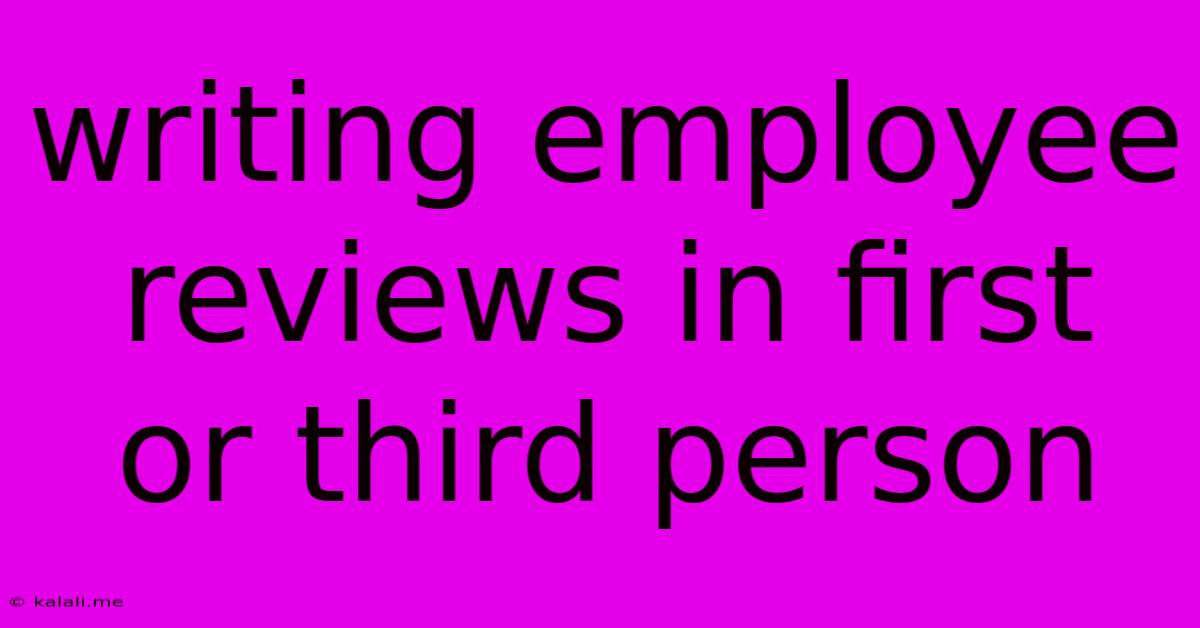Writing Employee Reviews In First Or Third Person
Kalali
Jun 09, 2025 · 3 min read

Table of Contents
Writing Employee Performance Reviews: First Person vs. Third Person
Choosing between first-person and third-person perspectives when writing employee performance reviews is a crucial decision impacting the overall tone, effectiveness, and perceived authenticity of the evaluation. This article explores the advantages and disadvantages of each approach, helping you determine the best method for your organization's needs and fostering more productive employee-manager relationships. This guide will cover the nuances of each approach, offering valuable insights to improve the overall review process.
The First-Person Perspective: Employee Self-Assessment and Collaboration
In a first-person review, the employee writes their own assessment of their performance, reflecting on their accomplishments, challenges faced, and areas for improvement. This approach fosters a sense of ownership and encourages self-reflection, critical for personal and professional growth.
Advantages:
- Increased Employee Engagement: Employees feel more involved and valued when they actively participate in their performance evaluation. This leads to higher buy-in and commitment to improvement plans.
- Authentic Voice: The first-person narrative allows for a more honest and genuine portrayal of the employee's experiences and perspectives.
- Improved Self-Awareness: The process of self-assessment encourages employees to critically examine their strengths and weaknesses, promoting continuous self-improvement.
- Facilitates Open Dialogue: The self-assessment serves as a strong foundation for a more open and collaborative discussion between the employee and manager during the review meeting.
Disadvantages:
- Potential for Bias: Employees might be overly lenient in assessing their performance, potentially overlooking areas needing improvement.
- Lack of Objectivity: The self-assessment might lack the objectivity and balanced perspective that a manager's evaluation can provide.
- Inconsistency in Style and Depth: The quality and thoroughness of self-assessments can vary significantly across employees.
- Requires Training and Guidance: Employees may need training and support to effectively conduct self-assessments.
The Third-Person Perspective: Manager's Objective Evaluation
The traditional approach involves the manager writing the review in the third person, objectively assessing the employee's performance based on observations, data, and documented evidence.
Advantages:
- Objectivity and Impartiality: The third-person perspective allows for a more detached and unbiased assessment, minimizing personal feelings and subjective opinions.
- Clear and Concise Feedback: A well-written third-person review provides clear and concise feedback, focusing on specific accomplishments and areas for development.
- Consistent Formatting and Structure: Third-person reviews generally follow a consistent format and structure, ensuring consistency across all evaluations.
- Easy Comparison: Using a consistent third-person format makes it easier to compare employee performance across the organization.
Disadvantages:
- Can Feel Distant and Impersonal: The third-person perspective can feel distant and impersonal, potentially damaging the employee-manager relationship.
- Limited Employee Input: The employee’s voice is absent, potentially leading to feelings of disengagement and resentment.
- Risk of Misinterpretation: The lack of direct employee input can increase the chances of misinterpretation or miscommunication.
- Potential for Bias (despite objective aim): While aiming for objectivity, unconscious biases can still influence the manager's assessment.
Hybrid Approach: The Best of Both Worlds?
Many organizations are moving towards a hybrid approach, incorporating elements of both first-person and third-person perspectives. This might involve the employee completing a self-assessment that the manager then reviews and supplements with their own observations and feedback. This collaborative approach often provides the most balanced and effective review process.
Conclusion:
The choice between first-person and third-person perspectives in performance reviews depends on various factors, including organizational culture, managerial styles, and employee expectations. However, the trend is leaning towards more collaborative and inclusive methods that empower employees to actively participate in their performance evaluations. A hybrid model, combining self-assessment and managerial feedback, often offers the best balance of objectivity, engagement, and improved communication. By carefully considering the advantages and disadvantages of each approach, organizations can create a performance review process that is both effective and beneficial for both employees and the organization as a whole.
Latest Posts
Latest Posts
-
How To Make All Text Upper In Google Sheet
Jun 09, 2025
-
Getting Warm In A Sunny Window Heat Transfer
Jun 09, 2025
-
What States Do Not Require A Front License Plate
Jun 09, 2025
-
How Much Hellstone Ore For A Full Set
Jun 09, 2025
-
This Is Why We Cant Have Nice Things Meme
Jun 09, 2025
Related Post
Thank you for visiting our website which covers about Writing Employee Reviews In First Or Third Person . We hope the information provided has been useful to you. Feel free to contact us if you have any questions or need further assistance. See you next time and don't miss to bookmark.